by tmoffett | Apr 10, 2012 | Color, Landscape, Photographic Philosophy, Ramblings
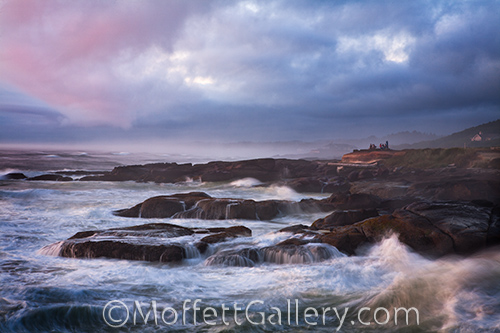
Storm Watchers
Having returned from a Spring Break trip to Moab, Utah, I have settled back in to the routine, sort of. My students are preparing for our big state photography competition that is later this week, my seniors are getting ready for their final show, big projects in my intermediate classes are coming due, personal project deadlines are fast approaching, Spring projects around the house need completed and I am trying to keep my head on straight and not show my stress through it all! This time of year always feels like being on the stormy seas. Then it all will pass and I will begin moving forward again, just in time to have the craziness start all over again. Life seems to get that way frequently for me. Maybe it is just to make me stretch a little. It definitely gets me out of my comfort zone, but always, at least in the past, has been for my good.
I am planning a trip in early May to photograph on the Oregon Coast. The stresses of April will have past and I will be able to find some time for relaxation and regrouping at one of my favorite places on this planet. Even in foul weather on the coast, great photographs await those brave enough to battle the elements. This image attests to that. Enduring the storm and waves, waiting for the perfect clouds, light and waves was a bit miserable, but upon capturing this image, it all became worth it! I have learned that if great effort is made, good things will nearly always be the result. This is not just in photography, but in life itself as well.
by tmoffett | Apr 5, 2012 | Color, Composition, Landscape, Photographic Philosophy, Portraits, Ramblings
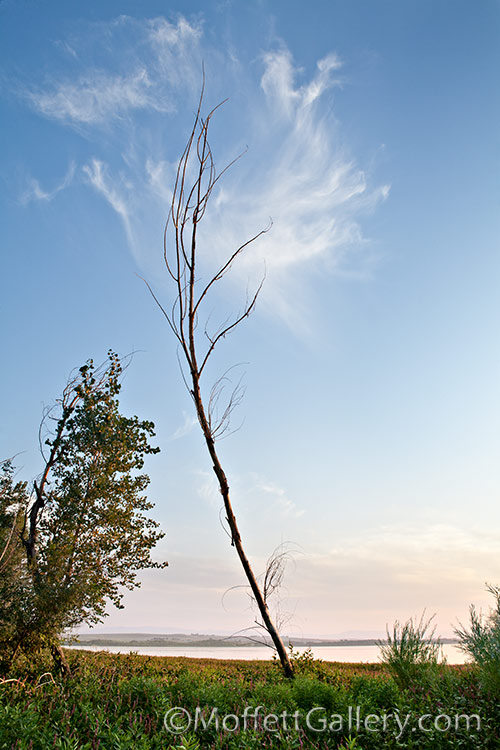
Reaching Upward
While out photographing one evening with a small group of students this image presented itself to me. The students all were hurrying out to the shore of the lake while I took my time observing and enjoying the environment. It was a great teaching moment the next day as I showed the image that everyone had passed up in an effort to get to the final destination. This was my favorite image of the evening. I hope that my students learned something from the experience.
I have learned much from other photographers. Some I have met, others just learned from their photographs. Here a few of my favorite photographers, but by no means is this an all inclusive list. I could list a hundred others who have in some way or another influenced me and my work.
1. Paul Caponigro He will always be on the top of my list. Paul Caponigro is my all time favorite. His images of Stonehenge and other megaliths are very moving. He has a way of really showing emotion in his photographs. I never tire of his photographs.
2. Henri Cartier-Bresson Famed for coining the phrase “The decisive moment.” His simple journalistic style and masterful composition make his images one of a kind. Finding a location and waiting patiently for the right moment to appear in is lens is something that we can all learn from.
3. Yousef Karsh My favorite portrait photographer of all time is Karsh. He had a way of capturing the soul of his subject. This, I believe, can only truly be accomplished by spending time with the subject, which he did. Learning who your subject is and then carefully crafting the portrait with perfect lighting and natural posing are a few of the things that Karsh’s portraits have inspired me to do. A Karsh portrait really communicates.
4. Arnold Newman Another portrait artist whose work has had a great influence on me. He was a master of the environmental portrait with a very simple style.
5. James Nachtwey The importance of being trusted by your subject is evident in his work. His photographs speak for his subjects and can make a difference in the world. Nachtwey brings a very intimate approach to war photography that makes him an advocate for peace.
6. Jay Maisel It’s all about light, shape and color. Find photographs in your everyday world and surroundings. They are there, we just need to find them. That is what Jay Maisel has taught me.
7. Irving Penn I really like his still life images. Simple, yet powerful composition and masterful lighting skills make his photographs some of my favorites.
8. John Sexton His black and white landscape photographs are inspiring. Learning to photograph in the quiet light at the end of the day after the sun has set is something I have learned from the images of John Sexton. Many of his images have a very peaceful, simple look that is very fresh. He is another whose images I never tire of.
My list could go on and on. Everyone has a favorite that could be added, but these are a few of mine. As I look at the work of these eight photographers, the common thread I see that draws me to their work is simplicity. They all have a way of making simple, powerful images. That is something that I have been trying to master for as long as I can remember. The simpler a photograph, the more power that it has. In our complex world, simple is also very refreshing. It is easy to look at. It is peaceful. It communicates. I have learned that by studying the work of other artists and photographers my own work improves. I only wish that I had more time to devote to looking at photographs.
by tmoffett | Apr 3, 2012 | Color, Composition, Landscape, Photographic Technique
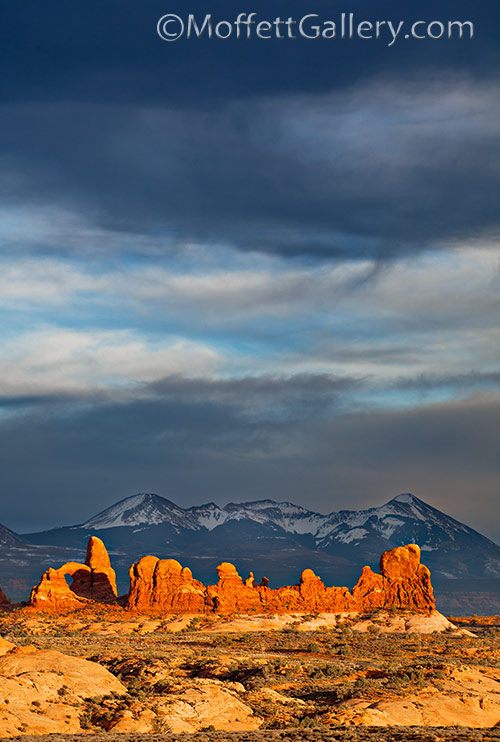
Arches National Park, Moab, Utah
As a landscape photographer I chase light. I have found that when the light quality is great, the resulting photograph will be great. The contrary is also true. If light quality suffers, so will the photograph, even if the location and composition are great. Add great composition to great light and it gets even better, then add emotion and the image becomes spectacular.
All last week I spent in the Moab, Utah area. Arches National Park, Canyonlands and Dead Horse Point all offer interesting subject matter for photographers. The difference maker for good or great photographs becomes light quality. All week long the light quality was good at best, not great. Then the last evening I was there, everything set up quite nicely. Dark clouds began to move in to the east. Heavy clouds were in the west interfering with the light, but there was a small band of clear sky between the horizon and the cloud cover. I watched and waited, knowing that just before sunset, the sun would break out and bathe the rock formations to the east with warm light. I was not disappointed, it happened just as expected. Photographers all over the park were treated to a scene that does not frequently occur. I was in in awe. It lasted only a few minutes and was gone. That few minutes is what being a photographer is all about.
by tmoffett | Mar 26, 2012 | Color, Landscape, Ramblings
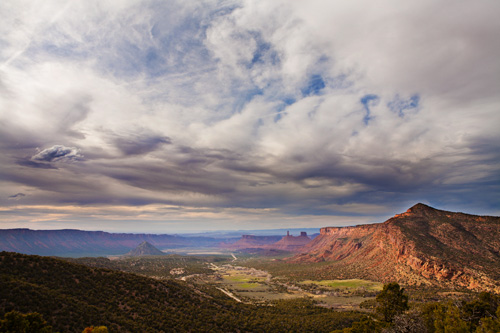
View from the La Sal Mountain Loop
My family is the most important thing in the world to me. Most all of my photography trips are combination trips where family time and photography time are combined. This trip is no different. Yesterday was a very laid back day. We attended church and then went for a Sunday Drive in the afternoon. I have been to Moab, Utah before, but spent most of my time at Arches National Park, so am really unfamiliar with the rest of what is here. We decided to explore. The weather was heavy overcast for most of the day, so the light was not very exciting, so not a great time for photography. We had a great time anyways, and at the same time found some great locations for when the light is better.
My wife and kids are the greatest! While I am sure they often get tired of me stopping to check out a view, then get out my gear even though the light is not perfect, or the wind is howling, or it’s cold outside, they never say a negative word. Sometimes they will get out and photograph with their point and shoot cameras, other times they will help me with my gear and at times just sit patiently in the truck. Sometimes I feel like I am selfish and do only what I want, and I probably am, but they never complain. I am totally blessed beyond measure.
I love photographing in locations that are not often photographed. I like trying to make the ordinary appear extraordinary. That was another reason for the drive yesterday. While we are near several National Parks that offer great views, they are also some of the most photographed locations in the world. It is very difficult to come up with my own personal images when I have been influenced by so many images already made in these places. I will spend some time in the National Parks, but will also spend time in other locations that draw my attention. I like finding my own “tripod holes,” so to speak.
The image above is one taken on the afternoon drive yesterday. It is a view toward the Moab Valley from the La Sal Mountains. We arrived at a clearing where we could see into the valley just as the sunlight broke through an opening in the clouds for only a minute. It was one of those times that I knew I had to make an image at that moment, because if I didn’t, the light would be gone, and it was. No time to change locations, just set up the best composition possible in about 30 seconds and shoot.
Ninety miles and five hours later we arrived back at the hotel. My seven year old was asleep, my thirteen year old stating, “I’m hungry,” and my wife still with a smile on her face. We ate supper, played some games and then off to bed. I love working vacations!
by tmoffett | Mar 23, 2012 | Color, Composition, Landscape, Photographic Philosophy

Clear Night, Arches National Park
It’s Spring Break here in Idaho, and time for another photography field trip! I’ll be photographing near Moab, Utah for the next few days and I am really looking forward to it. These kind of trips are very refreshing and help keep me fresh. It seems like a while since I have been out of my “Home Territory,” and will be a much needed break. I am a real advocate of photographing where you live, however an occasional road trip with the camera will do wonders for the revitalization of the soul.
In anticipation of this trip, I was reviewing some images made from a trip to Moab last summer. I came across this panorama that I shot at the end of the day when it was just about too dark to even focus the camera. That is one of my favorite times to shoot. It was a cloud free night and I found this horizon line to be quite interesting. It looked kind of like my lifeline, some ups and downs, maybe some bumps and bruises, yet constantly moving forward. I usually like a few good clouds, but this image, with its clean and simple design works just fine. God is the ultimate designer, and if we are observant enough, can find the beauty in whatever He places in front of us. That is the challenge. Find the beauty in the chaotic world in which we live. It is there. We must just simplify our vision in order to find it.
by tmoffett | Mar 21, 2012 | Color, Landscape, Photographic Philosophy, Photographic Technique
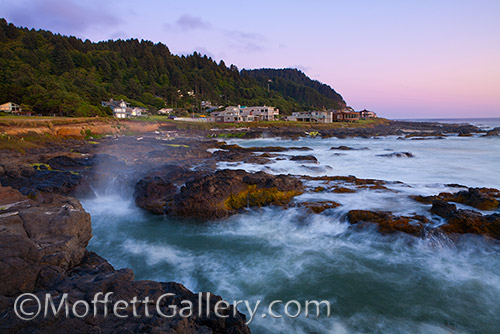
View From Ocean Drive, Yachats, OR
Photography means writing or drawing with light. Knowing this, it would then make sense that the better the light, the better the photograph. As simple as this concept may seem, it is sometimes hard to get students to understand it. So often I hear students in the process of researching other photographers work question why their own images don’t look more like the professionals. More often than not it comes down to light. You may be in a great location and have a great composition, but without great light you’ll end up with a mediocre photograph.
As the sun moves across the sky the color and quality of light that reaches the surface of the earth changes. The warm, soft light at sunrise turns to a cool and harsh light with deep shadows by mid-morning on a cloud-free summer day. By late evening the warm, soft light with rich, open shadows returns and slowly change to a soft cooler light after the sun sets. Coming to know these changes and learning to recognize what light quality will produce the mood and feeling that you want to elicit in your finished photograph are key to creating powerful images. For landscape photography, more often than not the early morning or late evening will produce the most desirable result.
There is one time of day that is often forgotten when it comes to making photographs; after the sun has set. I will often arrive at a location and watch as others are packing up and leaving and I am just getting started. A tripod is a must for making photos after sunset, but the mood and feeling rendered can be quite unlike anything that can be captured during the day. I will work many times until it is too dark to focus the camera.
The image above was taken just after sunset. You can see the warm pastel colors on the horizon, shifting to cooler tones in the upper sky. The warm light still on the horizon skims across the surface and illuminates the west face of the rocks and the buildings, while the cooler light from above illuminates the shadows and reflect off of the water. These subtle shifts in hue are what create some of the drama and interest in this image. Being patient and waiting for the right moment to press the shutter is much of what photography is about. Ansel Adams said, “Sometimes I do get to places just when God’s ready to have somebody click the shutter.” I believe that Ansel Adams had a very good understanding of light and placed himself at the right places and at the right times to take advantage of the beauty that God put in front of his lens.








Recent Comments